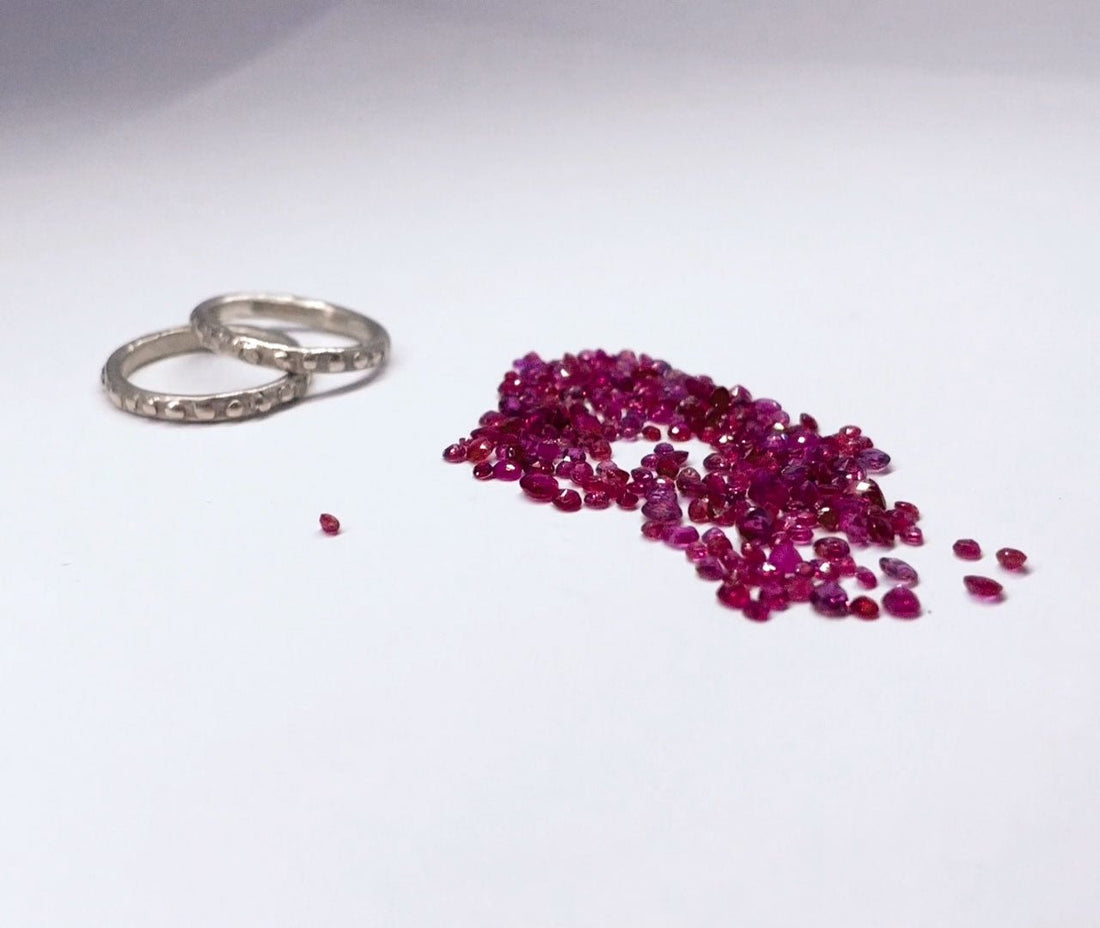
Ruby: The Enchanting July Birthstone
Share

A Ruby is a gemstone that captures your heart with its deep red hues and timeless beauty. As the birthstone for July, it holds a special significance for me and is highly coveted among gem enthusiasts worldwide. I wrote this blog post as part of my research into rubies. Come with me and explore the fascinating world of rubies, their origin, symbolism, and care.
The Origin and Meaning of Ruby
Derived from the Latin word "ruber," meaning "red," the ruby aptly represents the colour of love and passion. Its vivid crimson shade has the power to captivate and leave a lasting impression. The finest rubies, often referred to as "pigeon's blood," exhibit a deep red colour with a hint of purple. These precious gemstones belong to the corundum mineral species, which also includes sapphires.
The allure of rubies lies in their chromium content, as trace amounts of this element imbue the gem with its characteristic red hue. The more chromium present, the more vibrant the red colour becomes. Consequently, rubies can command the highest per-carat prices among coloured gemstones, making them highly sought after in the market.
The mineral Corundum comes in all colours of the rainbow but is most commonly found as opaque crystals with dull colours. Red corundum is called ruby, blue corundum is called sapphire, and all other colours are called fancy sapphires.

The Significance of Ruby Throughout History
Rubies are a gemstone steeped in history and symbolism. Across various cultures and time periods, it has been associated with power, wisdom, and vitality. In ancient India, the ruby was hailed as the "king of precious stones" due to its rarity, hardness (second only to diamond), and mystical properties. It was believed to hold the key to eternal youth and served as a symbol of power and energy.
Throughout the ages, rubies have been regarded as a source of good fortune and protection. Burmese warriors believed that wearing rubies made them invincible in battle, while medieval Europeans believed the gem bestowed health, wisdom, wealth, and success in love. Its fiery red colour, akin to an inextinguishable flame, evoked a sense of passion and vitality that captured the imagination of countless individuals.
Where Rubies Are Found
The quest for rubies takes us to diverse corners of the globe. Myanmar, formerly known as Burma, holds a prominent place as one of the oldest recorded sources of fine rubies. The Mogok region in Myanmar has produced exquisite rubies for over five centuries, characterized by their vibrant red hue and unique light-scattering inclusions. Marble formations and ancient Buddhist temples set the backdrop for these magnificent treasures.
Vietnam has also emerged as a significant ruby source, particularly the Luc Yen region in the north. Amidst rainforest-clad mountains and sprawling paddy fields, rubies of various shades of red, including purplish red, are discovered. Further south, the Quy Chau district has also yielded numerous high-quality rubies. In recent years, Mozambique has emerged as an important source, with the Montepuez mines producing gems comparable to the renowned rubies of Mogok. The world’s most expensive Ruby - the Estrela de FURA was mined on Mozambique and is the first Ruby to make the top 10 that was mined outside of Burma (Myanmar).
Other regions contributing to the global ruby supply include Thailand-Cambodia border areas, Afghanistan, Tajikistan, Pakistan, Sri Lanka, Kenya, Tanzania, and Madagascar. Each location brings its unique characteristics and allure to the world of rubies.
Caring for Your Ruby
To maintain the brilliance and beauty of your ruby, proper care is essential. Many rubies undergo heat treatment to enhance their colour and clarity. While this treatment is generally accepted in the gem trade, it is crucial to inquire about any additional treatments the stone may have undergone.
Cleaning a ruby is typically a straightforward process. Warm soapy water and a soft brush are usually sufficient to remove dirt and grime. Ultrasonic and steam cleaners are generally safe for untreated, heat-treated, and lattice diffusion-treated rubies. However, it's important to note that glass-filled or dyed stones should only be cleaned with a damp cloth to avoid potential damage.
Embrace the Timeless Beauty of Ruby
Whether you are born in July or simply captivated by the allure of rubies, owning one of these precious gemstones is a rare and precious privilege. The rich history, mesmerizing colour, and enduring symbolism of rubies make them a remarkable choice for any occasion. As a symbol of passion, love, and success, a ruby is a gift that truly speaks from the heart.
Fun Facts About Ruby
- In Sanskrit, ruby is called "ratnaraj," meaning the king of gems.
- Myanmar's Mogok valley is renowned as the source of many legendary rubies.
- The biggest ruby ever to come to auction was sold in New York in June 2023 for a record sum of US$34.8m ($56.8m). Sotheby's, which auctioned the 55.22-carat gem known as Estrela de Fura, described it as a "once-in-a-lifetime" jewel.
- Rubies belong to the corundum mineral species, with a chemical composition of Al2O3.
- Polished rubies of more than five carats are extremely uncommon.
- It has a refractive index of 1.762 to 1.770 and a specific gravity of 4.00 (+/- 0.05).
- Ruby ranks 9 on the Mohs hardness scale, showcasing its exceptional durability.
